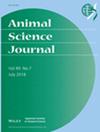This study evaluated carcass weight and physicochemical properties of loin and leg meat parts of Saanen castrated goats (n = 4) reared by grazing for 5 months in an abandoned rice field with concentrate supplements, comparing with meat of goats (n = 4) reared by confined feeding with grass silage and concentrate. Carcass and meat part weights of goats in the grazing group were lower (p < 0.01) than confined group. Shear force and cooking loss of meat showed no differences between the feeding groups. For meat color, L* value of loin meat tended to be lower (p < 0.15) for the grazing group compared with the confined group. Moisture content tended to be higher, but fat content tended to be lower (p < 0.15) in loin meat for the grazing group. Carnosine and alanine contents in loin meat were higher (p < 0.05) for the grazing group. Polyunsaturated fatty acid composition in meat was higher (p < 0.05), whereas monounsaturated fatty acid composition was lower (p < 0.05) for the grazing group. Phytanic acid content in both meat parts showed higher value (p < 0.05) for the grazing group. These results indicate that goat meat produced by grazing system in an abandoned rice field contains beneficial compounds for human health.


